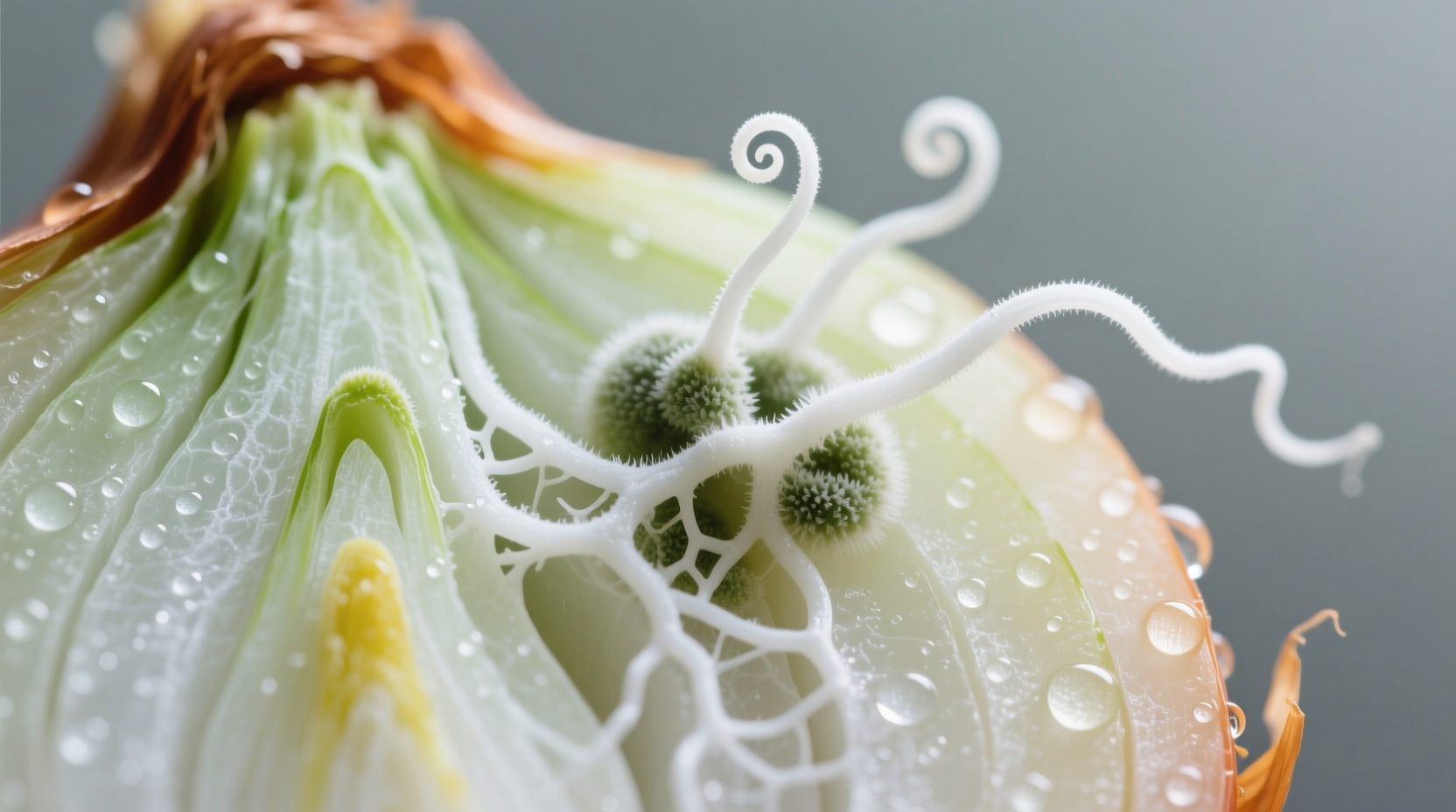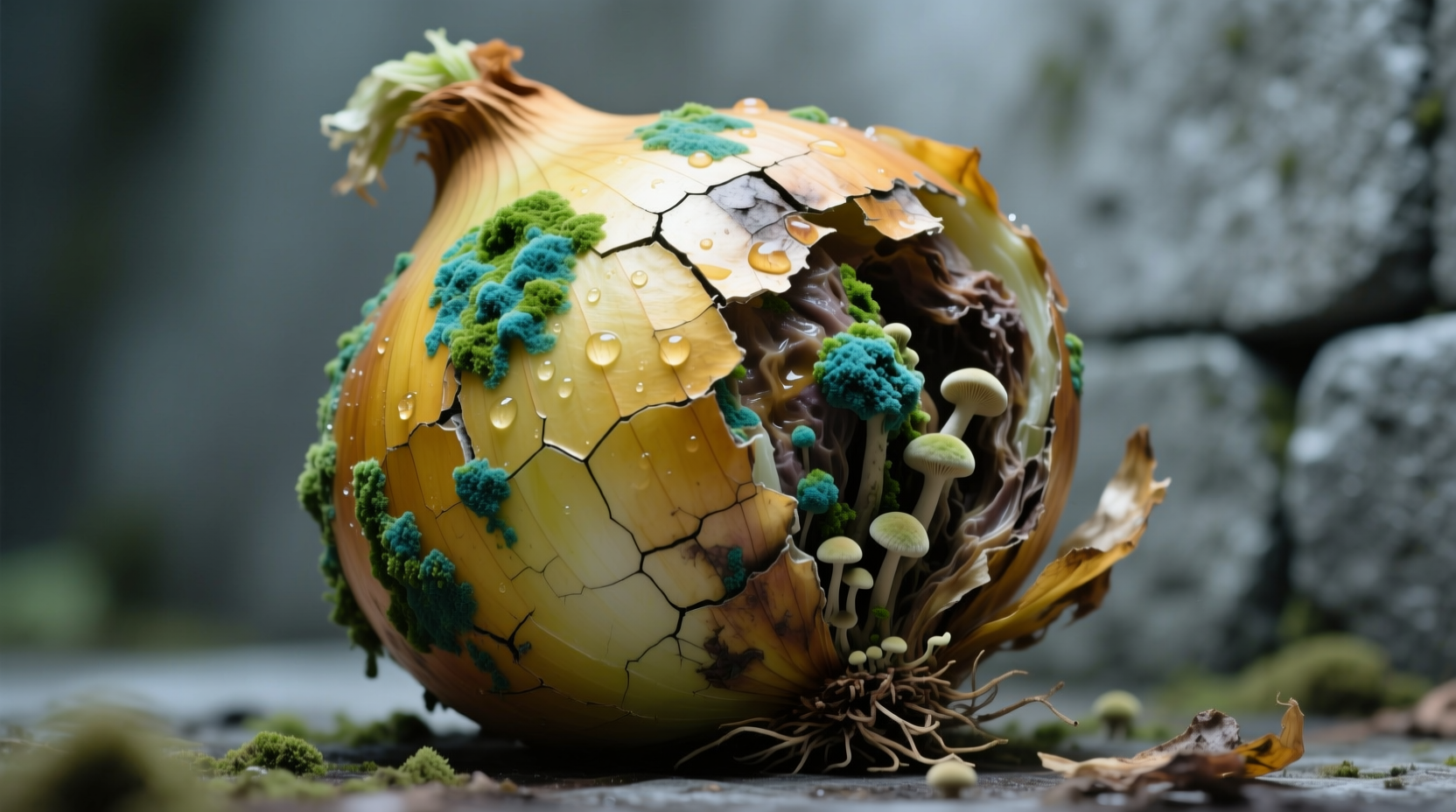Discover exactly why moldy onions pose a unique food safety risk and how to properly handle them. This guide provides science-backed information on mold development in onions, clear guidelines for when to discard affected produce, and practical storage techniques to extend your onions' shelf life by weeks. You'll learn the specific risks of consuming mold-contaminated onions, how to identify early spoilage signs before mold appears, and evidence-based storage methods that prevent mold growth.
Why Onions Are Different: The Mold Penetration Problem
Unlike firm vegetables such as carrots or bell peppers where surface mold can sometimes be cut away with a margin of safety, onions present a unique challenge. Their layered structure creates pathways for mold to penetrate deep into the bulb, often invisible to the naked eye. Food safety researchers at Cornell University's Department of Food Science have documented how Aspergillus and Penicillium species—common molds found on onions—can extend hyphae (root-like structures) throughout the entire bulb within 48 hours of initial surface contamination.
When mold appears on the outer skin of an onion, it's already compromised. The USDA Food Safety and Inspection Service explicitly states that soft, porous vegetables like onions, mushrooms, and tomatoes should be discarded entirely when mold is detected, as the mold filaments have likely penetrated beyond visible areas.
| Vegetable Type | Mold Penetration Risk | Safe Salvage Possible? | Recommended Action |
|---|---|---|---|
| Onions, Garlic | Very High | No | Discard entire bulb |
| Carrots, Bell Peppers | Low | Yes (with 1-inch margin) | Cut away affected area |
| Bread, Soft Cheeses | Very High | No | Discard entire item |
| Hard Cheeses | Low | Yes (with 1-inch margin) | Cut away affected area |
Understanding Mold Development Timeline on Onions
Mold growth on onions follows a predictable progression that begins long before visible signs appear. Understanding this timeline helps prevent consumption of contaminated produce:
- Day 1-3: Microscopic mold spores land on onion surface (invisible to naked eye)
- Day 4-5: Initial moisture absorption begins weakening protective outer layers
- Day 6-7: First visible signs appear as small white or fuzzy spots on outer skin
- Day 8-10: Mold penetrates through layers; internal contamination becomes likely
- Day 11+: Mycotoxin production begins; entire bulb becomes unsafe
This progression, documented by researchers at the National Center for Home Food Preservation, explains why waiting until mold is clearly visible means the onion is already compromised. The FDA Food Code emphasizes that visible mold indicates significant microbial growth that likely extends beyond what's visible.
When Partial Salvage Might Be Possible (Rare Exceptions)
While the general rule is to discard moldy onions entirely, there are extremely limited circumstances where partial salvage might be considered—though still not recommended:
- Single isolated spot on very outer dry skin of a firm onion with no other signs of spoilage
- No soft spots or discoloration beneath the affected area
- Immediate use after removing at least 1 inch around the affected area
Even in these rare cases, food safety experts from the University of California Division of Agriculture and Natural Resources caution that the risk remains significant due to onions' structure. The context boundary here is critical: this exception applies only to dry outer skins of firm onions with no other spoilage indicators. Any softness, discoloration, or multiple mold spots means the entire onion must be discarded.
Proper Onion Storage: Extending Freshness by Weeks
Preventing mold starts with proper storage. Onions require specific conditions to maximize shelf life and prevent mold development:
- Airflow is critical: Store in mesh bags, baskets, or paper bags—not plastic
- Temperature matters: Ideal range is 45-55°F (7-13°C) with 65-70% humidity
- Separation is key: Keep away from potatoes which emit moisture-accelerating gases
- Location considerations: Dark, dry pantry is better than refrigerator (except for sweet onions)
According to USDA storage guidelines, proper conditions can extend yellow onion shelf life to 2-3 months, compared to just 1-2 weeks in suboptimal conditions. Sweet onions like Vidalias have higher moisture content and should be refrigerated, lasting only 2-3 weeks even under ideal conditions.

Early Warning Signs Before Mold Appears
Recognizing these early spoilage indicators can help you use onions before mold develops:
- Soft spots: Any area that yields slightly to gentle pressure
- Sprouting: Green shoots emerging from top indicate aging process
- Color changes: Yellowing or browning beyond normal outer skin
- Texture changes: Slimy feel or unusual stickiness on surface
- Odor changes: Musty or sour smell instead of characteristic onion scent
When you notice any of these signs, use the onion immediately or discard it. The European Food Safety Authority notes that these early changes indicate compromised cellular structure that creates ideal conditions for rapid mold development.
What Happens If You Accidentally Eat Moldy Onion?
While most healthy adults might experience only mild digestive upset from accidentally consuming small amounts of moldy onion, certain populations face serious risks. The mycotoxins produced by mold can cause symptoms ranging from nausea and vomiting to more severe reactions in immunocompromised individuals.
According to clinical reports documented by the Centers for Disease Control and Prevention, vulnerable populations including young children, elderly individuals, and those with compromised immune systems may experience more severe reactions. If you experience persistent symptoms after consuming moldy food, seek medical attention and mention the possible mycotoxin exposure.
FAQ: Moldy Onion Questions Answered
Can I cut mold off an onion and eat the rest?
No, you should not cut mold off an onion and eat the remaining portion. Unlike hard vegetables where surface mold can sometimes be removed with a margin of safety, onions' layered structure allows mold to penetrate throughout the entire bulb. The USDA recommends discarding soft vegetables like onions entirely when mold is detected.
How can I tell if an onion has mold before it becomes visible?
Early signs of mold development include soft spots when gently pressed, musty odors, slimy texture, or discoloration beyond the normal outer skin. If an onion feels unusually soft in any area or has an off smell, it's beginning to spoil and should be used immediately or discarded.
How long do onions last before they get moldy?
Properly stored yellow onions typically last 2-3 months in a cool, dark pantry with good airflow. Sweet onions like Vidalias last only 2-3 weeks even under ideal conditions. Refrigeration extends the life of sweet onions but can actually shorten the shelf life of regular onions by increasing moisture exposure.
Why do my onions keep getting moldy even when stored properly?
Onions may develop mold prematurely if stored near moisture sources like potatoes, in plastic bags that trap humidity, or in areas with temperature fluctuations. Ensure your storage location maintains consistent temperature (45-55°F/7-13°C) with 65-70% humidity and good airflow using mesh or paper bags instead of plastic.











 浙公网安备
33010002000092号
浙公网安备
33010002000092号 浙B2-20120091-4
浙B2-20120091-4